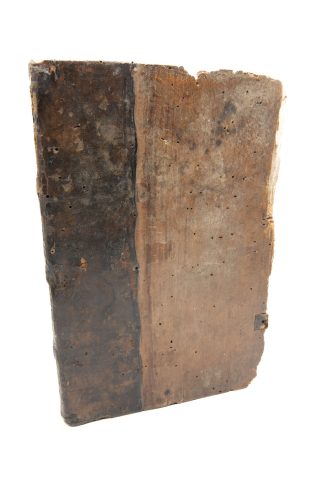JUSTINUS, Marcus Junianus. [and] FLORUS, Lucius Annaeus. [with] LUCIAN OF SAMOSATA. [and] DIODORUS SYCULUS.
EARLIEST SURVIVING WORK OF SCIENCE FICTION
Epitome in Trogi Pompeii. [and] Epitomae. [with] Verae historiae. [and] Bibliotheca seu historiarum libri VI.
[Venice] [with] Venice, [Johannes Rubeus Vercellensis for Antonius Moretus] [with] Philippus Pincius, [c.1494] [with] 20 November 1493.£8,950.00
Folio. 2 works in 1. I: ff. 54; II: [8], XLIV, [1, blank]. Roman letter. Many fore-edges untrimmed, some frayed, intermittent light waterstaining, mostly to blank margins, handful of small scattered worm holes, heavier to initial and final gatherings, occasional minor ink marks. Good, well-margined copies, on good-quality paper, in contemporary quarter brown goatskin over wooden boards, lacking clasps, worming to boards, loss to fore-edge of boards and to leather on lower cover, upper joint cracked at head, spine anciently restored, occasional C16 ms notes. Preserved in folding box.
In the original C15 binding, two of the most important textbooks of the medieval period. The second work, largely untrimmed, opens with the second edition of Lucian of Samosata’s ‘Verae Historiae’ (2nd cent.), considered the earliest surviving work of science fiction. A famous satirist, Lucian begins by stating his account is, in fact, a big lie, and proceeds to narrate the most surreal and fantastic adventures, described as ‘historiae’, which bring to exaggeration some of the classic commonplaces of ancient histories. The author and his fellow travellers go beyond the Pillars of Hercules. Flying through space, they reach the Moon – which Lucian describes – where they strive to avoid a war between the King of the Moon and the King of the Sun, and their armies made of alien creatures, for the colonization of the Morning Star. They are later swallowed by a whale so big its stomach is inhabited, they see gigantic insects, and meet the heroes of Troy on the Island of the Blessed, as well as speaking statues much resembling automata, and ‘intelligent’ lamps who have formed their own society. ‘With this celestial war, the wondrous and bizarre creatures, and Lucian’s ability to venture into space, the notion of utopian and even modern science fiction has been raised in the context of “Verae Historiae”’ (Clay, p.38), including such commonplace tropes as gigantic creatures or societies formed by sentient objects, with implicit comparison to human society. The second text, Diodorus Siculus’s (1st cent.) ‘Bibliotheca historica’, is a history which encompasses the whole known world, from Mesopotamia to India, Egypt, Arabia, Africa and Europe, with great attention to the Empire of Alexander the Great.
First printed in 1470, the first work includes two ‘epitomae’, i.e., compilations. The Roman historian Justinus (2nd cent. AD) compiled the most interesting and useful excerpts from Pompeius Trogus’ ‘Liber Historiarum Philippicarum’ (1st cent. AD), here edited by the Bolognese humanist Philippus Beroaldus. It is a history of the Kings of Macedonia and an ethnographic and geographical account of the territories eventually conquered by Alexander the Great. It is followed by a compendium of Roman history by Lucius Annaeus Florus (c.1st cent AD), a major historian born in Africa under Emperor Hadrian. The ‘epitome’ is based on Livy’s ‘Ab Urbe Condita’, and reaches down to 25BC, touching on the causes of Rome’s expansion and decline. Untrimmed, original copies.
I: ISTC ij00620500; Goff J619; HC 9653*; BMC V, 421; GW M15644. II: ISTC il00328000; Goff L328; BMC V 495; GW M19065. D. Clay, Lucian, True History (2021).In stock





